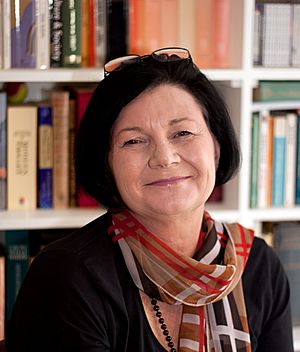Elizabeth Grant (anthropologist) facts for kids
Quick facts for kids
Elizabeth Grant
CF
|
|
|---|---|
 |
|
| Born | 23 August 1963 Mount Gambier, South Australia, Australia
|
| Died | 5 July 2022 (aged 58) Clayton Bay, South Australia, Australia
|
| Alma mater | The University of Adelaide |
| Known for | Architectural researcher, anthropologist, criminologist and academic |
| Spouse(s) | Leonard Cohen |
| Children | 3 |
| Awards | Churchill Fellowship |
| Scientific career | |
| Fields | Architecture, Indigenous architecture Human Rights |
| Institutions | RMIT School of Architecture and Design |
Elizabeth Grant (born August 23, 1963 – died July 5, 2022) was an important Australian expert. She studied how buildings are designed, especially for Indigenous Australians. She was an architectural anthropologist, which means she looked at how people and their cultures connect with buildings. She was also a criminologist, studying crime and justice, and an academic, meaning she taught and researched at universities.
Elizabeth Grant was known for her work in Indigenous architecture. This field focuses on creating buildings and spaces that respect and serve the needs of Indigenous communities. She believed that architecture could help improve human rights, especially in places like prisons and courts. She wanted these buildings to be fair and suitable for everyone.
She was a Churchill Fellow, which is a special award that allowed her to travel and research. She taught at several universities, including The University of Adelaide and RMIT University. She often spoke on the radio about topics like housing for Indigenous people and making public spaces welcoming for them.
Contents
Her Work in Architecture
Elizabeth Grant focused on designing buildings and environments for Indigenous people. She wanted to make sure these places were kind and culturally right for the people using them. Her goal was to show respect for Indigenous cultures through excellent building design.
Designing Fair Buildings
Much of her work looked at how to design buildings like prisons, detention centers, and courts. She also worked on housing for Indigenous people who have a disability. She helped make sure these buildings were humane and met the needs of the people inside.
She helped with important government reviews and investigations. For example, she contributed to the Royal Commission into the Protection and Detention of Children in the Northern Territory. She pushed for better conditions for Aboriginal people in custody. She also wanted to stop children from being kept alone in detention.
Changing How Buildings Are Made
Grant's research changed how prisons, courts, and schools are designed for Indigenous people. Her ideas were used in Australia and other countries. Her work on prison design was very important. It led to new rules for how detention centers should be built for Indigenous prisoners.
In 2015, her research was recognized by the International Corrections and Prisons Association. As a Churchill Fellow, she visited correctional facilities in the United States, New Zealand, Canada, and Denmark. She studied how they designed these places for Indigenous prisoners.
Working on Big Projects
Elizabeth Grant was part of the design teams for many building projects. These included centers for Aboriginal children and families. She also worked on major hospital and prison projects. Her goal was always to make these places better for Indigenous users.
Looking at History
Grant also worked with historians to study old buildings and how Indigenous Australians were treated long ago. They looked at the famous Boab Prison Tree, Derby in Western Australia. Many people believed this tree was used to imprison Aboriginal people.
However, Grant found that this was a myth. Her research showed there was no proof that the tree was ever used as a prison. This discovery was even featured in National Geographic magazine. She also researched how chains were used to control Aboriginal people in the past.
Sharing Knowledge
Grant helped edit a very important book called The Handbook of Contemporary Indigenous Architecture. This book is the first to give a full international overview of modern Indigenous architecture. It shares ideas and practices from experts in Australia, New Zealand, Canada, and other countries.
She was also part of the Australian team for the 17th Venice Architecture Biennale. This is a big international event about architecture. Their exhibit, called 'In Between', showed how architecture can help different cultures understand each other. It focused on Australia, New Zealand, and other Pacific neighbors.
Her Education
Elizabeth Grant earned her first degree in architecture from the University of Adelaide. She also earned a Graduate Diploma and a master's degree in Environmental Studies.
For her master's project, she studied how Aboriginal housing developed at Oak Valley, South Australia. This was after land rights were given to the Maralinga Tjarutja people. She spent a lot of time living with the Traditional Owners and Senior Women there. This experience deeply influenced her work and life. She became known as someone who understood Indigenous knowledge.
Later, she earned her Doctor of Philosophy (PhD) in Architecture from the University of Adelaide. Her PhD research focused on making environments safer and more suitable for Aboriginal prisoners.
Her Personal Life
Elizabeth Grant grew up in Mount Gambier, South Australia. She spent a lot of her childhood with her grandparents in Sea Lake, Victoria. Her father, Berthold Enderl, came from Germany and highly valued education. He encouraged his children to study hard, saying "education is the only thing that cannot be taken away from you."
Elizabeth was the first in her family to finish high school and go to university. She lived in Adelaide and Melbourne. She was married to Leonard (Tamahae) Cohen, a Māori bluegrass musician from New Zealand. He was a founding member of the Hamilton County Bluegrass Band.
Elizabeth and Leonard had three sons: Todd, Paul, and Tim. She even appeared on the TV show The Amazing Race Australia with her eldest son, Todd.

